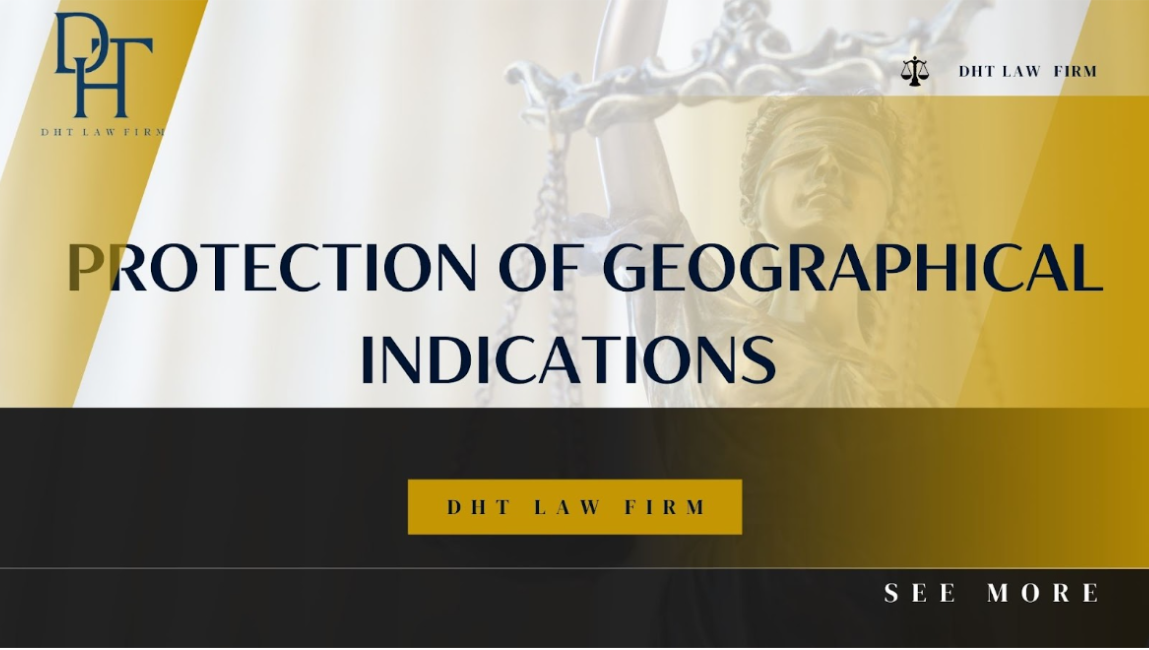
PROTECTION OF GEOGRAPHICAL INDICATIONS
Newsletter by Legal Specialist at Dai Ha Thanh Law Firm - Nguyen Phuong Thao - Bachelor of Law, graduated with High - distinction from Hanoi Law University.
1. Geographical indication
1.1. What is a geographical indication
According to Clause 22, Article 4 of the 2005 Intellectual Property Law, amended by Point d, Clause 1, Article 1 of the 2022 Amended Intellectual Property Law, "geographical indication" is defined as follows: "Geographical indication is a sign refers to the geographical origin of a product from a specific region, locality, territory or country.”
The reputation of products bearing geographical indications depending on geographical conditions is determined by the level of consumers’ credibility.
Geographic conditions considered to bring reputation and specific quality to products include: Natural factors (climate, hydrology, geology, topography, ecosystem and other natural conditions); Human factors (skills and techniques of producers, traditional local production processes...).
These conditions are determined by one or several qualitative, quantitative or sensory criteria of physics, chemistry, microbiology and those criteria must be capable of being tested by technical or specialized means. with appropriate testing methods.
1.2. Difference between geographical indication and trademark
|
|
|
|
|
|
|
|
|
|
|
|
|
|
|
|
|
|
|
|
|
|
|
|
|
|
|
|
|
|
|
|
2. Protection of geographical indications
2.1. Conditions for protection of geographical indications
Geographical indications play an important role in protecting the rights of consumers and legitimate producers. Famous geographical indications are often associated with certain qualities and characteristics of products, creating brand value for manufacturers. Unless they are fully protected, they can be exploited and used illegally by dishonest trading partners.
Illegal abuse of geographical indications will cause damage to both consumers and legal producers. Consumers will be deceived and buy fake products that do not meet expected quality. Meanwhile, legitimate manufacturers will lose business opportunities and brand reputation.
Therefore, accurate and complete protection of geographical indications is necessary to prevent illegal exploitation and ensure the legitimate rights of relevant parties.
2.2. Procedures for registration of geographical indication protection
2.2.1. Required documents
According to Article 100 of the 2005 Intellectual Property Law, amended and supplemented by Clause 32, Article 1 of the 2022 Amended Intellectual Property Law, required documents and general requirements for industrial property registration, specifically Register for geographical indication protection as follows:
- 02 Geographical Indication registration declarations, typed according to form number: 05-CDĐL, Appendix A of Circular 01/2007/TT-BKHCN;
- A description of the specific characteristics/quality and/or reputation of the product;
- Map of the geographical area corresponding to the geographical indication;
- Proof of payment of fees and charges.
In addition to the above documents, the following documents may be included:
- Power of attorney (if the geographical indication registration application is submitted through an industrial property representation service organization);
- Document confirming permission to use special signs (if the protection request contains symbols, flags, badges of domestic and international agencies and organizations...);
- Documents confirming registration rights;
- Documents confirming the enjoyment of registration rights from another person;
- Documents proving priority rights (if the application requires priority rights).
2.2.2. Application form
Applicants can choose to submit a paper application or submit an online application through the online public service portal of the National Office of Intellectual Property, specifically as follows:
a) Form of paper application (in person)
Applicants can submit an application for geographical indication registration in person or via postal service to one of the application receiving points of the National Office of Intellectual Property, specifically:
- Headquarters of the Department of Intellectual Property/ Representative offices of the Department of Intellectual Property in cities.
In case of submitting the application for geographical indication registration by post, the applicant needs to transfer money through the post office service, then photocopy the Money Transfer Receipt and send it along with the application dossier to one of the reception points. Receive the above application from the National Office of Intellectual Property to prove the amount paid.
(Note: When transferring fees and charges to one of the above application receiving points of the National Office of Intellectual Property, the applicant needs to send the dossier via corresponding post office to that application receiving point).
b) Online application form (online)
- Conditions for online application submission: Applicants need to have a digital certificate and digital signature, register an account on the Online Application Receiving System and have their account approved by the National Office of Intellectual Property to carry out transactions. Translation of industrial property rights registration.
- Online Application Submission Process:
Step 1: The applicant needs to declare and submit the geographical indication registration application on the online application receiving system of the National Office of Intellectual Property.
Step 2: After completing the declaration and submitting the application on the Online Application Receiving System, the System will send back to the applicant "Confirmation of online document submission".
Step 3: Within 01 month from the date of submitting the online application, the applicant must go to one of the application receiving points of the National Office of Intellectual Property on working days during business hours to present the Document Confirmation. Submit documents online and accompanying documents (if any) and pay fees/charges according to regulations.
If the documents and fees are complete as prescribed, the application receiving officer will issue the application number to the Declaration on the Online Application Receiving System. If the documents and fees are insufficient as prescribed, the application will be rejected..
In case the Applicant does not complete the application procedure as prescribed, the online documents will be canceled and a Notice of Cancellation of Online Documents will be sent to the Applicant on the Online Application Receiving System.
2.2.3. Fees and charges for geographical indication registration
Based on the schedule of fees and charges for industrial property registration, issued with Circular 263/2016/TT-BTC, the specific fees are as follows:
- Application fee: 150,000 VND
- Application publication fee: 120,000 VND
- Lookup fee for content appraisal: 180,000 VND
- Content appraisal fee: 1,200,000 VND
2.2.4. Time limit for processing geographical indication registration applications
According to Article 109, 110, 119 of the 2005 Intellectual Property Law, amended by Clause 38, Article 1 of the 2022 Amended Intellectual Property Law, from the date it is received by the National Office of Intellectual Property, the geographical indication registration application is considered according to the procedure. following order:
- Formal appraisal: 01 month
- Application announcement: within 02 months from the date the geographical indication registration application has a decision accepting the valid application
- Content appraisal: no more than 06 months from the date of publication of the application.
Above is the information about geographical indications according to Vietnamese law. In addition to information about geographical indications, you can also refer to the article “NEWEST REGULATIONS ON THE ORDER AND PROCEDURES FOR IMPLEMENTATION OF TRADEMARK REGISTRATION” by DHT to have better understanding of the legal regulations related to trademark protection registration in Vietnam.
In addition, the issue of infringement of geographical indications is also a noteworthy feature. The article “CURRENT STATUS OF TRADEMARK INFRINGEMENT AND SOME NOTES ON PROCEDURE OF TRADEMARK REGISTRATION IN VIETNAM” DHT provides detailed information about the current situation of trademark infringement and offers recommendations. Some note when registering a trademark in Vietnam. Having a better understanding of these issues helps you possess a comprehensive view and have an effective brand protection plan.
Dai Ha Thanh Law Company Limited, with a team of professionally trained domestic and foreign lawyers and legal advisors, is committed to providing professional legal services to our customers. If you need detailed advice, please contact us to receive professional and effective legal consulting services.
